Come comment on this article: Anker Soundcore Model Zero+ review: Weird design, killer sound
Anker Soundcore Model Zero+ review: Weird design, killer sound appeared first on http://www.talkandroid.com
Come comment on this article: Anker Soundcore Model Zero+ review: Weird design, killer sound
Four billion miles from Earth, the New Horizons probe that recently sent such lovely pictures of Pluto is drawing near to the most distant object mankind has ever come close to: Ultima Thule, a mysterious rock deep in the Kuiper belt. The historic rendezvous takes place early tomorrow morning.
This is an encounter nearly 30 years in the making, if you count back to the mission’s beginnings in 1989, but it’s also been some 13 years since launch — the timing and nature of which was calculated to give the probe this opportunity after it had completed its primary mission.
New Horizons arrived at Pluto in the summer of 2015, and in its fleeting passage took thousands of photos and readings that scientists are still poring over. It taught us many things about the distant dwarf planet, but by the time it took its extraordinary parting shots of Pluto’s atmosphere, the team was already thinking about its next destination.
Given the craft’s extreme speed and the incredibly distant setting for its first mission, the options for what to investigate were limited — if you can call the billions of objects floating in the Kuiper Belt “limited.”
In fact the next destination had been chosen during a search undertaken in concert with the Hubble Space Telescope team back in 2014. Ground-based reconnaissance wasn’t exact enough, and the New Horizons had to convince Hubble’s operators basically to dedicate two weeks of the satellite’s time on short notice to their cause. After an initial rejection and “some high-stakes backroom maneuvering,” as Principal Investigator Alan Stern describes it in his book about the mission, the team made it happen and Hubble data identified several potential targets.
2014 MU69 is a rock of unknown (but probably weird) shape about 20 miles across, floating in the belt about a billion miles from Pluto. But soon it would be known by another name.
“Ultima Thule,” Stern told me in an interview on stage at Disrupt SF in September. “This is an ancient building block of planets like Pluto, formed 4 billion years ago; it’s been out there in this deep freeze, almost in absolute zero the whole time. It’s a time capsule.”
At the time, he and the team had just gotten visual confirmation of the target, though nothing more than a twinkle in the distance. He was leaving immediately after our talk to go run flyby simulations with the team.
“I’m super excited,” he told me. “That will be the most distant exploration of any world in the history of not just spaceflight, but in the history of human exploration. I don’t think anybody will top that for a long time.”
The Voyagers are the farthest human-made objects, sure, but they’ve been flying through empty space for decades. New Horizons is out here meeting strange objects in an asteroid belt. Good luck putting together another mission like that in less than a few decades.
In the time I’ve taken to write this post, New Horizons has gone from almost exactly 600,000 kilometers away from Ultima Thule to under 538,000 (and by this you shall know my velocity) — so it’ll be there quite soon. Just about 10 hours out, making it very early morning Eastern time on New Year’s Day.
Even then, however, that’s just when New Horizons will actually encounter the object — we won’t know until the signal it sends at the speed of light arrives here on Earth 12 hours later. Pluto is far!
The first data back will confirm the telemetry and basic success of the flyby. It will also begin sending images back as soon as possible, and while it’s possible that we’ll have fabulous pictures of the object by the afternoon, it depends a great deal on how things go during the encounter. At the latest we’ll see some by the next day; media briefings are planned for January 2 and 3 for this purpose.
Once those images start flowing in, though, they may be even better in a way than those we got of Pluto. If all goes well they’ll be capturing photos at a resolution of 35 meters per pixel, more than twice as good as the 70-80 m/px we got of Pluto. Note that these will only come later, after some basic shots confirming the flyby went as planned and allowing the team to better sort through the raw data coming in.
The New Horizons team reports the spacecraft is healthy and on track for the historic flyby of #UltimaThule just after midnight tonight! Watch flyby events live on NASATV and @JHUAPL starting at 2pm (ET): https://t.co/eMJrTOiPxQ | https://t.co/Zan07qh3OJ https://t.co/B3FxqIe6XN
— NASA New Horizons (@NASANewHorizons) December 31, 2018
“You should know that that these stretch-goal observations are risky,” wrote Stern in a post on the mission’s page, “requiring us to know exactly where both Ultima and New Horizons are as they pass one another at over 32,000 mph in the darkness of the Kuiper Belt… But with risk comes reward, and we would rather try than not try to get these, and that is what we will do.”
NASA public relations and other staff are still affected by the federal shutdown, but the New Horizons team will be covering the signal acquisition and first data live anyway; follow the mission on Twitter or check in to the NASA Live stream tomorrow morning at 7 AM Pacific time for the whole program. The schedule and lots of links can be found here.
Come comment on this article: New website AOSMark grades Android manufacturers on Android updates
Come comment on this article: Essential says they’re not done after all
While the thought of a machine that can squirt out endless ropes of molten glass is a bit frightening, the folks at MIT have just about perfected the process. In a paper published in 3D Printing and Additive Manufacturing, researchers Chikara Inamura, Michael Stern, Daniel Lizardo, Peter Houk, and Neri Oxman describe a system for 3D printing glass that offers far more control over the hot material and the final product.
Their system, called G3DP2, “is a new AM platform for molten glass that combines digitally integrated three-zone thermal control system with four-axis motion control system, introducing industrial-scale production capabilities with enhanced production rate and reliability while ensuring product accuracy and repeatability, all previously unattainable for glass.”
The system uses a closed, heated box that holds the melted glass and another thermally controlled box where it prints the object. A moveable plate drops the object lower and lower as it is being printed and the print head moves above it. The system is interesting because it actually produces clear glass structures that can be used for decoration or building. The researchers take special care to control the glass extrusion system to ensure that it cools down and crystallizes without injecting impurities or structural problems.
“In the future, combining the advantages of this AM technology with the multitude of unique material properties of glass such as transparency, strength, and chemical stability, we may start to see new archetypes of multifunctional building blocks,” wrote the creators.
Come comment on this article: Essential Phone is finally out of rope, showing out of stock from most retailers
Come comment on this article: LG is the latest to join the South Korean FTC lawsuit against Qualcomm
Come comment on this article: [TA Deals] Grab this discounted 4K UHD Action Camera for $70
It seems someone took Every Frame a Painting literally: The Very Slow Movie Player is a device that turns cinema into wallpaper, advancing the image by a single second every hour. The result is an interesting household object that makes something new of even the most familiar film.
The idea occurred to designer and engineer Bryan Boyer during one of those times we all have where we are sitting at home thinking of ways to celebrate slowness.
“Can a film be consumed at the speed of reading a book?” he asked himself, slowly. “Slowing things down to an extreme measure creates room for appreciation of the object… but the prolonged duration also starts to shift the relationship between object, viewer, and context. A film watched at 1/3,600th of the original speed is not a very slow movie, it’s a hazy timepiece. A Very Slow Movie Player (VSMP) doesn’t tell you the time; it helps you see yourself against the smear of time.”
The Very Slow Movie Player is an e-paper display attached to a Raspberry Pi board; you load a movie onto the latter, and it processes and displays a single frame at a time, updating the screen with a new one every two and a half minutes.
That adds up to 24 frames per hour, as opposed to the usual 24 frames per second — 3,600 times slower than normal viewing, and producing a (perhaps) 7-or-8,000-hour tableau you view over the course of a year or so.
“It is impossible to ‘watch’ in a traditional way because it’s too slow. In a staring contest with VSMP you will always lose,” writes Boyer in a post explaining the project. “It can be noticed, glanced at, or even inspected, but not watched.”
He compares it to the work of Bill Viola, whose super-slow-motion portraits are similarly impossible to watch from start to finish (unless you’re very, very patient) and therefore exist in a sort of limbo between motion picture and still image.
The image itself leaves something to be desired, of course: e-paper is essentially 1-bit color depth — black and white. So the subtleties of color you might see in any film, color or no, will be lost to dithering.
The way it’s done helps highlight the contrasts and zones of a scene, though if you really want to appreciate Rear Window as cinema, you can watch it any time you like. But if you want to appreciate it as a process, as a relationship with time, as an object and image that exists in the context of the rest of the world and your life… for that, you have the Very Slow Movie Player.
Come comment on this article: [Video] Check out our BenQ Trevolo S electrostatic speaker review!
Come comment on this article: LG G8 set to have a waterdrop notch and 3D sensing camera, but it won’t be 5G
We are living in an interstitial period. In the early 1980s we entered an era of desktop computing that culminated in the dot-com crash – a financial bubble that we bolstered with Y2K consulting fees and hardware expenditures alongside irrational exuberance over Pets.com. That last interstitial era, an era during which computers got smaller, weirder, thinner, and more powerful, ushered us, after a long period of boredom, into the mobile era in which we now exist. If you want to help innovate in the next decade, it’s time to admit that phones, like desktop PCs before them, are a dead end.
We create and then brush up against the edges of our creation every decade. The speed at which we improve – but not innovate – is increasing and so the difference between a 2007 iPhone and a modern Pixel 3 is incredible. But what can the Pixel do that the original iPhone or Android phones can’t? Not much.
We are limited by the use cases afforded by our current technology. In 1903, a bike was a bike and could not fly. Until the Wright Brothers and others turned forward mechanical motion into lift were we able to lift off. In 2019 a phone is a phone and cannot truly interact with us as long as it remains a separate part of our bodies. Until someone looks beyond these limitations will we be able to take flight.
While I won’t posit on the future of mobile tech I will note that until we put our phones away and look at the world anew we will do nothing of note. We can take better photos and FaceTime each other but until we see the limitations of these technologies we will be unable to see a world outside of them.
We’re heading into a new year (and a new CES) and we can expect more of the same. It is safe and comfortable to remain in the screen-hand-eye nexus, creating VR devices that are essentially phones slapped to our faces and big computers that now masquerade as TVs. What, however, is the next step? Where do these devices go? How do they change? How to user interfaces compress and morph? Until we actively think about this we will remain stuck.
Perhaps you are. You’d better hurry. If this period ends as swiftly and decisively as the other ones before it, the opportunity available will be limited at best. Why hasn’t VR taken off? Because it is still on the fringes, being explored by people stuck in mobile thinking. Why is machine learning and AI so slow? Because the use cases are aimed at chatbots and better customer interaction. Until we start looking beyond the black mirror (see what I did?) of our phones innovation will fail.
Every app launched, every pictured scrolled, every tap, every hunched-over moment davening to some dumb Facebook improvement, is a brick in bulwark against an unexpected and better future. So put your phone down this year and build something. Soon it might be too late.
A project by students at Carnegie Mellon could save lives. Called the HopeBand, the wristband senses low blood oxygen levels and sends a text message and sounds an alarm if danger is imminent.
“Imagine having a friend who is always watching for signs of overdose; someone who understands your usage pattern and knows when to contact [someone] for help and make sure you get help,” student Rashmi Kalkunte told IEEE. “That’s what the HopeBand is designed to do.”
The team won third place in the Robert Wood Johnson Foundation’s Opioid Challenge at the Health 2.0 conference in September and they are planning to send the band to a needle exchange program in Pittsburgh. They hope to sell it for less than $20.
Given the more than 72,000 overdose deaths in America this year a device like this could definitely keep folks a little safer.
There’s a lot of talk about the many potential uses of multi-legged robots like Cheetahbot and Spot — but in order for those to come to fruition, the robots actually have to go out and do stuff. And to train for a glorious future of sewer inspection (and helping rescue people, probably), this Swiss quadrupedal bot is going deep underground.
The robot is called ANYmal, and it’s a long-term collaboration between the Swiss Federal Institute of Technology, abbreviated there as ETH Zurich, and a spinoff from the university called ANYbotics. Its latest escapade was a trip to the sewers below that city, where it could eventually aid or replace the manual inspection process.
ANYmal isn’t brand new — like most robot platforms, it’s been under constant revision for years. But it’s only recently that cameras and sensors like lidar have gotten good enough and small enough that real-world testing in a dark, slimy place like sewer pipes could be considered.
Most cities have miles and miles of underground infrastructure that can only be checked by expert inspectors. This is dangerous and tedious work — perfect for automation. Imagine instead of yearly inspections by people, if robots were swinging by once a week. If anything looks off, it calls in the humans. It could also enter areas rendered inaccessible by disasters or simply too small for people to navigate safely.
But of course, before an army of robots can inhabit our sewers (where have I encountered this concept before? Oh yeah…) the robot needs to experience and learn about that environment. First outings will be only minimally autonomous, with more independence added as the robot and team gain confidence.
“Just because something works in the lab doesn’t always mean it will in the real world,” explained ANYbot co-founder Peter Fankhauser in the ETHZ story.
Testing the robot’s sensors and skills in a real-world scenario provides new insights and tons of data for the engineers to work with. For instance, when the environment is completely dark, laser-based imaging may work, but what if there’s a lot of water, steam, or smoke? ANYmal should also be able to feel its surroundings, its creators decided.
So they tested both sensor-equipped feet (with mixed success) and the possibility of ANYmal raising its “paw” to touch a wall, to find a button or determine temperature or texture. This latter action had to be manually improvised by the pilots, but clearly it’s something it should be able to do on its own. Add it to the list!
You can watch “Inspector ANYmal’s” trip below Zurich in the video below.
Come comment on this article: [TA Deals] Protect yourself online with a discounted Heimdal Thor Premium subscription (80% off)
Fitness trackers and heart rate monitors are all well and good, but if you want to track activity inside the body, the solutions aren’t nearly as convenient. Iota Biosciences wants to change that with millimeter-wide sensors that can live more or less permanently in your body and transmit what they detect wirelessly, and a $15 million series A should put them well on their way.
The team emerged from research at UC Berkeley, where co-founders Jose Carmena and Michel Maharbiz were working on improving the state of microelectrodes. These devices are used all over medical and experimental science to monitor and stimulate nerves and muscle tissues. For instance, a microelectrode array in the brain might be able to help detect early signs of a seizure, and around the heart one could precisely test the rhythms of cardiac tissues.
But despite their name, microelectrodes aren’t really small. The tips, sure, but they’re often connected to larger machines, or battery-powered packs, and they can rarely stay in the body for more than a few weeks or months due to various complications associated with them.
Considering how far we’ve come in other sectors when it comes to miniaturization, manufacturing techniques, and power efficiency, Carmena and Maharbiz thought, why don’t we have something better?
“The idea at first was to have free floating motes in the brain with RF [radio frequency] powering them,” Carmena said. But they ran into a fundamental problem: RF radiation, because of its long wavelength, requires rather a large antenna to receive them. Much larger than was practical for devices meant to swim in the bloodstream.
“There was a meeting at which everything died, because we were like two orders of magnitude away from what we needed. The physics just weren’t there,” he recalled. “So were like, ‘I guess that’s it!’ ”
But some time after, Carmena had a ‘eureka’ moment — “as weird as it sounds, it occurred to me in a parking lot. You just think about it and all these things align.”
His revelation: ultrasound.
You’re probably familiar with ultrasound as a diagnostic tool, for imaging inside the body during pregnancy and the like — or possibly as a range-finding tool that “pings” nearby objects. There’s been a lot of focus on the venerable technology recently as technologists have found new applications for it.
In fact, a portable ultrasound company just won TechCrunch’s Startup Battlefield in Lagos:
Iota’s approach, however, has little to do with these traditional uses of the technology. Remember the principle that you have to have an antenna that’s a reasonable fraction of an emission’s wavelength in order to capture it? Well, ultrasound has a wavelength measured in microns — millionths of a meter.
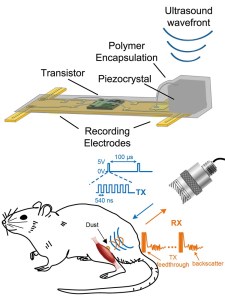 So it can be captured — and captured very efficiently. That means an ultrasound antenna can easily catch enough waves to power a connected device.
So it can be captured — and captured very efficiently. That means an ultrasound antenna can easily catch enough waves to power a connected device.
Not only that, but as you might guess from its use in imaging, ultrasound goes right through us. Lots of radiation, including RF, gets absorbed by the charged, salty water that makes up much of the human body.
“Ultrasound doesn’t do that,” Maharbiz said. “You’re just jell-o — it goes right through you.”
The device they put together to take advantage of this is remarkably simple, and incredibly tiny. On one side is what’s called a piezoelectric crystal, something that transforms force — in this case, ultrasound — into electricity. In the middle is a tiny chip, and around the edge runs a set of electrodes.
It’s so small that it can be attached to a single nerve or muscle fiber. When the device is activated by a beam of ultrasound, voltage runs between the electrodes, and this minute current is affected by the electrical activity of the tissue. These slight changes are literally reflected in how the ultrasonic pulses bounce back, and the reader can derive electrophysiological voltage from those changes.
Basically the waves they send power the device and bounce back slightly changed, depending on what the nerve or muscle is doing. By sending a steady stream of pulses, the system collects a constant stream of precise monitoring data simply and non-invasively. (And yes, this has been demonstrated in in vivo.)
Contained inside non-reactive, implant-safe containers, these microscopic “motes” could be installed singly or by the dozen, doing everything from monitoring heart tissue to controlling a prosthesis. And because they can also deliver a voltage, they could conceivably be used for therapeutic purposes as well.
And to be clear, those purposes won’t be inside the brain. Although there’s no particular reason this tech wouldn’t work in the central nervous system, it would have to be smaller and testing would be much more complicated. The initial applications will all be in the peripheral nervous system.
At any rate, before any of that happens, they have to be approved by the FDA.
As you might guess, this isn’t the kind of thing you can just invent and then start implanting all over the place. Implants, especially electronic ones, must undergo extreme scrutiny before being allowed to be used in even experimental treatment.
Fortunately for Iota, their devices have a lot of advantages over, say, a pacemaker with a radio-based data connection and 5-year battery. The only transmission involved is ultrasound, for one thing, and there are decades of studies showing the safety of using it.
“The FDA has well-defined limits for average and peak powers for the human body with ultrasound, and we’re nowhere near those frequencies or powers. This is very different,” explained Maharbiz. “There’s no exotic materials or techniques. As far as constant low-level ultrasound goes, the notion really is that it does nothing.”
And unlike a major device like a medication port, pump, stint, pacemaker, or even a long-term electrode, “installation” is straightforward and easily reversible.
It would be done laparoscopically, or through a tiny incision. said Carmena. “If it has to be taken out, it can be taken out, but it’s so minimally invasive and small and safe that we keep it,” he said.
These are all marks in Iota’s favor, but testing can’t be rushed. Although the groundwork for their devices was laid in 2013, the team has taken a great deal of time to advance the science to the point where it can be taken out of the lab to begin with.
In order to get it now to the point where they can propose human trials, Iota has raised $15 million in funding; the round was led by Horizons Ventures, Astellas, Bold Capital Parners, Ironfire, and Shanda. (The round was in May but only just announced.)
The A round should get the company from its current prototype phase to a point, perhaps some 18 months distant, when they have a production-ready version ready to present to the FDA — at which point more funding will probably be required to get through the subsequent years of testing.
But that’s the game in medtech, and all the investors know it. This could be a hugely disruptive technology in a number of fields, although at first the devices need to be approved for a single medical purpose (one Iota has decided on but can’t disclose yet).
It’s a long road, all right, but at the end of it is the fulfillment of a promise straight out of sci-fi. It may be years before you have microscopic, ultrasound-powered doodads swimming around inside you, but that future is well on its way.
Come comment on this article: OnePlus drops the Android Pie 9.0 update for the OnePlus 5 and 5T
Come comment on this article: Maybe Android TV isn’t dying? Google announces the platform has tens of millions of users
Come comment on this article: Google Pixel 3 Lite set to release on Verizon in Spring 2019
Come comment on this article: Nokia 5.1 Plus gets its taste of Android Pie, rolling out now
Come comment on this article: Google’s hardware business could end up generating $20 billion by 2021
Alexa wasn’t the only thing that crashed over Christmas due to an influx of new users. Apparently, Philips Hue has been having an outage as well. A multi-day outage, in fact. The company confirmed on Wednesday that customers were experiencing issues creating new accounts, logging in, and linking their account to third parties. It blamed the issues on “a lot of new activations.”
In other words, many people received Hue’s connected lighting products over the holidays and were now trying to set up their smart bulbs and other devices all around the same time. Hue’s servers couldn’t keep up with the demand and weren’t responding to the incoming requests. That meant users couldn’t create or log into their MyHue account, or connect their lights to their Amazon Echo or Google Home.
Customers were, understandably, very frustrated – especially since their issues began on Christmas, and had continued for days with no word from the company.
It's been almost two full days of being unable to log into MyHue or connect with my Echo. You really should consider a small coupon for all the people affected this Christmas. Lots of other smart bulb options out there…
— John Daniel Hubbard (@JDanHubbard) December 27, 2018
It’s been two days.
— Holly Quate (@hollyquate) December 26, 2018
Others complained they had wasted several hours troubleshooting the problem, having not realized it was a Hue outage that was at fault, as a result of this lack of communication.
I find this out after wasting 5 hours of my St Stephens day trying to link my account to my google home assistant
Ridiculous
— Lorraine Comiskey (@Jewelor) December 26, 2018
I am so stressed spent 5 hours last night trying to troubleshoot and nothing your lights are awesome but the problem with the software is really killing it for me just spent $500 on your lights would be nice if I could control them with my google home
— Logan czarnecki (@LoganCzarnecki) December 26, 2018
Philips Hue’s Twitter account didn’t make a public announcement about the outage until Wednesday – instead, the company was only replying to individual users.
Because Twitter hides replies in a separate tab, visitors to Hue’s Twitter page wouldn’t have seen any statements from the company unless they clicked over to see the back-and-forth conversations with Hue’s customers – and some of those weren’t outage-related.
People who followed Hue on Twitter wouldn’t have seen these replies in their own timelines, either.
We’re currently seeing a lot of new activations which may result in some customers not being able to create a new account, log in, or link their account to third parties. We hope to have this solved soon and like to ask you to try again later. Apologies and happy holidays!
— Philips Hue (@tweethue) December 26, 2018
Philips Hue had also downplayed the problem in its initial replies, as well, saying server issues were affecting only a “small percentage” of users.
Customers were told to try again or try in a few hours.
Hi. Unfortunately we have been facing some issues with our servers, affecting a small percentage of our users. We advise you to try again, or try again in a few hours. Our developers are looking into it. We are sorry for the inconvenience.
— Philips Hue (@tweethue) December 26, 2018
While Alexa had crashed on Christmas due to a similar problem of too many new users hitting its servers all at once, its outage only lasted for a couple of hours.
In Philip Hue’s case, customers have been inconvenienced for much longer.
Many are also new Hue customers – those who are trying to trying to create their account and set up their devices for the first time. For some, Hue’s smart light bulbs may even be their first experience with a smart home device – and this outage may leave them not wanting to try again.
Early on Thursday, Hue’s Twitter account began to reply to individual users, telling them the service “should be up and running.”
But it also warned them that, depending on demand, they may have to try a few times today to get everything going. The company additionally suggested to some that they should try to set up the lights during off-peak hours, like the morning.
We reached out to Philips Hue to ask if the outage was indeed resolved, and will update with a statement if one is provided.
Hey Natalia, we are sorry about that. We can assure you that it will work again later and your present isn't ruined forever. At the moment the service should be up and running depending on the demand at the moment, so please try again a few times today. Our sincere apologies.
— Philips Hue (@tweethue) December 27, 2018
Hey Brad, the issue should now be resolved, during peak times you might still not be able to complete your account setup. We’d like to ask you to try again, preferably during a quieter moment, for example in the morning. We’re working hard on a solution to prevent this.
— Philips Hue (@tweethue) December 27, 2018
Come comment on this article: Trump considering “national emergency” to ban Huawei, ZTE in U.S.
Come comment on this article: [TA Deals] Grab a discounted subscription to ProtonVPN for 50% off!
SpaceX’s futuristic Starship interplanetary craft may embody the golden age of sci-fi in more ways than one: in addition to (theoretically) taking passengers from planet to planet, it may sport a shiny stainless steel skin that makes it look like the pulp covers of old.
Founder and CEO Elon Musk teased the possibility in a picture posted to Twitter, captioned simply “Stainless Steel Starship.” To be clear, this isn’t a full-on spacecraft, just part of a test vehicle that the company plans to use during the short “hopper” flights in 2019 to evaluate various systems.
As with most Musk tweets, this kicked off a storm of speculation and argument in the Twitterverse.
The choice surprised many because for years, modern spaceflight has been dependent on advanced composite materials like carbon fiber, which combine desirable physical properties with low weight. When metal has been required, aluminum or titanium are much more common. While some launch components, like the upper stage of the Atlas 5 rocket, have liberally used steel, it’s definitely not an obvious choice for a craft like the Starship, which will have to deal with both deep space and repeated reentry.
As Musk pointed out in subsequent comments, however, stainless steel has some advantages versus other materials when at extremely hot or cold temperatures.
Usable strength/weight of full hard stainless at cryo is slightly better than carbon fiber, room temp is worse, high temp is vastly better
— Elon Musk (@elonmusk) December 24, 2018
This is a special full-hardness steel alloy mentioned as being among the 300 series of high-strength, heat-resistant alloys — not the plentiful, pliable stuff we all have in our kitchens and buildings. Musk also mentioned another “superalloy” called SX500 that SpaceX’s metallurgists have developed for use in the Raptor engines that will power the vehicle.
So why stainless? It’s likely all about reentry.
Many craft and reusable stages that have to face the heat of entering the atmosphere at high speed use “ablative” heat shielding that disintegrates or breaks away in a controlled fashion, carrying heat away from the vehicle.
It’s unlikely this is a possibility for Starship, however, as replacing and repairing this material would necessitate downtime and crews wherever and whenever it lands, and the craft is meant to be (eventually) a quick-turnaround ship with maximum reusability. Heat shielding that reflects and survives is a better bet for that — but an enormous engineering problem.
Scott Manley put together a nice video illustrating some of these ideas and speculations in detail:
Musk said before of the Starship (then still called BFR) that “almost the entire time it is reentering, it’s just trying to brake, while distributing that force over the most area possible.” Reentry will probably look more like a Space Shuttle-esque glide than a Falcon 9 first stage’s ballistic descent and engine braking.
The switch to stainless steel has the pleasant side effect of making the craft look really cool — more in line with sci-fi books and comics than their readers perhaps ever thought to hope. Paint jobs would burn right off, Musk said:
Skin will get too hot for paint. Stainless mirror finish. Maximum relfectivity.
— Elon Musk (@elonmusk) December 24, 2018
You can’t expect it to stay shiny for long, though; it may be stainless, but like a pan you left on the stove, stainless steel can still scorch and the bottom of the Starship will likely look pretty rough after a while. It’s all right — spacecraft developing a patina is a charming evolution.
Details are still few, and for all we know SpaceX could redesign the craft again based on how tests go. Next year will see the earliest hopper flights for Starship hardware and possibly the Super Heavy lower stage that will lift its great shiny bulk out of the lower atmosphere.
The technical documentation promised by Musk should arrive in March or April, but whether it will pertain solely to the test vehicle or give a glimpse at the craft SpaceX intends to send around the moon is anyone’s guess. At any rate you should expect more information to be spontaneously revealed before then at Musk’s discretion — or lack thereof.
Amazon this morning said its Alexa devices were among the holiday season’s best-sellers, particularly the Echo and Echo Dot. But the influx of new users setting up their devices for the first time on Christmas Day appeared to be more than Alexa could handle. The service crashed briefly on Christmas, as thousands of new Alexa device owners tried to connect their Echo to Amazon’s servers around the same time.
The Guardian first reported the Alexa outage, which began around 10 AM GMT and led existing Echo owners to complain they were unable to use their devices for regular tasks like playing music or smart home controls, for example.
Others said they were unable to set up their device, despite not having any other internet or home Wi-Fi issues, which seemed to point to a server-side outage.
Amazon’s Twitter account noted the issues were isolated to Europe, saying at 8:43 AM EST (1:43 PM GMT): “Over the past two hours some Echo devices in Europe have had intermittent connections.” The outage was resolved by the time the account had responded, meaning it had only lasted a couple of hours.
An Amazon spokesperson also confirmed the outage to TechCrunch.
“For a short period yesterday morning we had an issue that intermittently impacted some Alexa customers’ ability to interact with the service,” the spokesperson said. “The Alexa service is now operating normally.”
Hey there. Over the past two hours some Echo devices in Europe have had intermittent connections. These issues have now been resolved and the Alexa Service is working normally. ^RY
— Amazon Help (@AmazonHelp) December 25, 2018
I'm sorry for the trouble! Some Echo devices in Europe had intermittent connections. These issues have now been resolved and the Alexa Service is working normally. Please let us know if it's still giving you trouble. ^BH
— Amazon Help (@AmazonHelp) December 25, 2018
Amazon declined to offer details on what caused the outage, or explain how it was resolved. Likely, it was related to the increased number of requests.
The website Down Detector had also spotted troubles with Alexa which impacted Europe, with a peak of 2,183 reports coming in at the height of the outage. The reports then tapered off a couple of hours later.
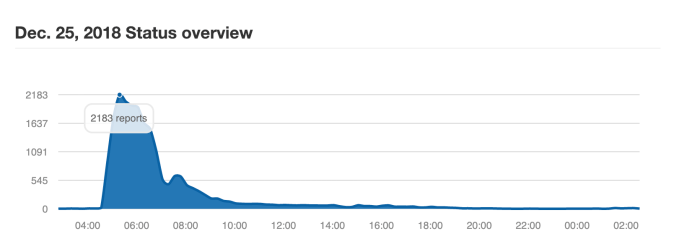

This isn’t Alexa’s first outage by any means, nor even its first this year. The service can become unresponsive at times, either due to server issues or overloads. In March, for example, the voice service went down even while the Alexa mobile app still worked.
And in September, Alexa went down across Europe, apparently related to an AWS outage in Ireland. That was followed by a U.S. outage the following month, which led the assistant to respond to requests with “sorry, something went wrong.”
Europe is a growing market for Alexa, with Amazon having introduced its smart speaker to Italy and Spain, this June. Alexa’s other international markets include the U.K., Australia, India, New Zealand, Germany, Japan and Ireland.
Researchers at the New Jersey Institute of Technology, while testing the “station keeping” functions of the glass knifefish, have created an augmented reality system that tricks the animal’s electric sensing organs in real time. The fish keeps itself hidden by moving inside of its various holes/homes and the researchers wanted to understand what kind of autonomous sensing functions it used to keep itself safe.
“What is most exciting is that this study has allowed us to explore feedback in ways that we have been dreaming about for over 10 years,” said Eric Fortune, associate professor at NJIT. “This is perhaps the first study where augmented reality has been used to probe, in real time, this fundamental process of movement-based active sensing, which nearly all animals use to perceive the environment around them.”
The fish isn’t wearing a headset but instead the researchers have simulated the motion of a refuge waving in the water.
“We’ve known for a long time that these fish will follow the position of their refuge, but more recently we discovered that they generate small movements that reminded us of the tiny movements that are seen in human eyes,” said Fortune. “That led us to devise our augmented reality system and see if we could experimentally perturb the relationship between the sensory and motor systems of these fish without completely unlinking them. Until now, this was very hard to do.”
To create their test they put a fish inside a tube and synced the motion of the tube to the fish’s eyes. As the fish swam forward and backward, the researchers would watch to see what happened when the fish could see that it was directly effecting the motion of the refuge. When they synced the refuge to the motion of the fish, they were able to confirm that the fish could tell that the experience wasn’t “real” in a natural sense. In short, the fish knew it was in a virtual environment.
“It turns out the fish behave differently when the stimulus is controlled by the individual versus when the stimulus is played back to them,” said Fortune. “This experiment demonstrates that the phenomenon that we are observing is due to feedback the fish receives from its own movement. Essentially, the animal seems to know that it is controlling the sensory world around it.”
Whether or not the fish can play Job Simulator is still unclear.
“Our hope is that researchers will conduct similar experiments to learn more about vision in humans, which could give us valuable knowledge about our own neurobiology,” said Fortune. “At the same time, because animals continue to be so much better at vision and control of movement than any artificial system that has been devised, we think that engineers could take the data we’ve published and translate that into more powerful feedback control systems.”
Come comment on this article: [TA Deals] Snag the RankActive SEO Toolkit for life with this discount! (98% off)
Come comment on this article: Google Duo hits a major milestone with 1 billion downloads from the Play Store
Come comment on this article: [TA Deals] Save 85% on the Arduino Uno Ultimate Starter Kit
A Juul is not a cigarette. It’s much easier than that. Through devilishly slick product design I’ll discuss here, the startup has massively lowered the barrier to getting hooked on nicotine. Juul has dismantled every deterrent to taking a puff.
The result is both a new $38 billion valuation thanks to a $12.8 billion investment from Marlboro Cigarettes-maker Altria this week, and an explosion in popularity of vaping amongst teenagers and the rest of the population. Game recognize game, and Altria’s game is nicotine addiction. It knows it’s been one-upped by Juul’s tactics, so it’s hedged its own success by handing the startup over a tenth of the public corporation’s market cap in cash.
Juul argues it can help people switch from obviously dangerous smoking to supposedly healthier vaping. But in reality, the tiny aluminum device helps people switch from nothing to vaping…which can lead some to start smoking the real thing. A study found it causes more people to pick up cigarettes than put them down.
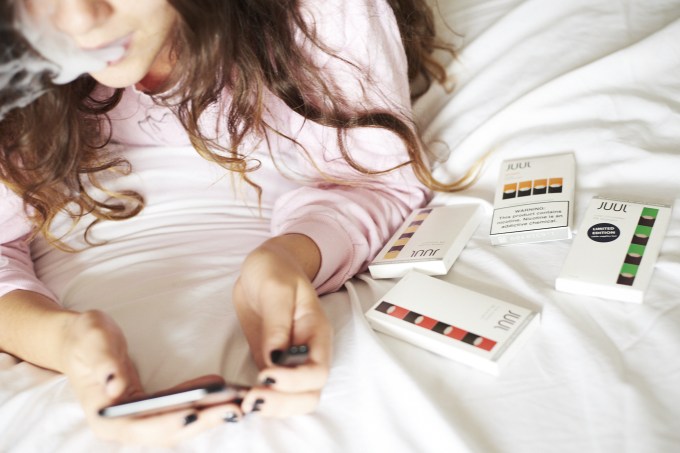
Photographer: Gabby Jones/Bloomberg via Getty Images
How fast has Juul swept the nation? Nielsen says it controls 75 percent of the U.S. e-cigarette market up from 27 percent in September last year. In the year since then, the CDC says the percentage of high school students who’ve used an e-cigarette in the last 30 days has grown 75 percent. That’s 3 million teens or roughly 20 percent of all high school kids. CNBC reports that Juul 2018 revenue could be around $1.5 billion.
The health consequences aside, Juul makes it radically simple to pick up a lifelong vice. Parents, regulators, and potential vapers need to understand why Juul works so well if they’ll have any hope of suppressing its temptations.
It’s tough to try a cigarette for the first time. The heat and smoke burn your throat. The taste is harsh and overwhelming. The smell coats your fingers and clothes, marking you as smoker. There’s pressure to smoke a whole one lest you waste the tobacco. Even if you want to try a friend’s, they have to ignite one first. And unlike bigger box mod vaporizers where you customize the temperature and e-juice, Juul doesn’t make you look like some dorky hardcore vapelord.
Juul is much more gentle on your throat. The taste is more mild and can be masked with flavors. The vapor doesn’t stain you with a smell as quickly. You can try just a single puff from a friend’s at a bar or during a smoking break with no pressure to inhale more. The elegant, discrete form factor doesn’t brand you as a serious vape users. It’s casual. Yet the public gesture and clouds people exhale are still eye catching to trigger the questions, “Whats that? Can I try?”
And perhaps most insidiously, vaping seems healthier. A lifetime of anti-smoking ads and warning labels drilled the dangers into our heads. But how much harm could a little vapor do?
A friend who had never smoked tells me they burn through a full Juul pod per day now. Someone got him to try a single puff at a nightclub. Soon he was asking for drag off of strangers’ Juuls. Then he bought one and never looked back. He’d been around cigarettes at parties his whole life but never got into them. Juul made it too effortless to resist.
Lighting up a cigarette is a garish activity prohibited in many places. Not so with discretely sipping from a Juul.
Cigarettes often aren’t allowed to be smoked inside. Hiding it is no easy feat and can get you kicked out. You need to have a lighter and play with fire to get one started. They can get crushed or damp in your pocket. The burning tip makes them unruly in tight quarters, and the bud or falling ash can damage clothing and make a mess. You smoke a cigarette because you really want to smoke a cigarette.
Public establishments are still figuring out how to handle Juuls and other vaporizers. Many places that ban smoking don’t explicitly do the same for vaping. The less stinky vapor and more discrete motion makes it easy to hide. Beyond airplanes, you could probably play dumb and say you didn’t know the rules if you did get caught. The metal stick is hard to break. You won’t singe anyone. There’s no mess, need for an ashtray, or holes in your jackets or couches.
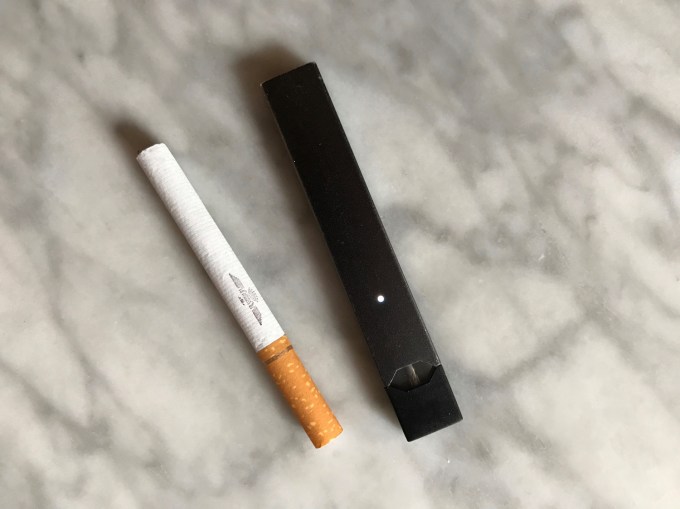
As long as your battery is charged, there’s no need for extra equipment and you won’t draw attention like with a lighter. Battery life is a major concern for heavy Juulers that smokers don’t have worry about, but I know people who now carry a giant portable charger just to keep their Juul alive. But there’s also a network effect that’s developing. Similar to iPhone cords, Juuls are becoming common enough that you can often conveniently borrow a battery stick or charger from another user.
And again, the modular ability to take as few or as many puffs as you want lets you absent-mindedly Juul at any moment. At your desk, on the dance floor, as you drive, or even in bed. A friend’s nieces and nephews say that they see fellow teens Juul in class by concealing it in the cuff of their sleeve. No kid would be so brazen as to try smoke in cigarette in the middle of a math lesson.
Gillette pioneered the brilliant razor and blade business model. Buy the sometimes-discounted razor, and you’re compelled to keep buying the expensive proprietary blades. Dollar Shave Club leveled up the strategy by offering a subscription that delivers the consumable blades to your door. Juul combines both with a product that’s physically addictive.
When you finish a pack of cigarettes, you could be done smoking. There’s nothing left. But with Juul you’ve still got the $35 battery pack when you finish vaping a pod. There’s a sunk cost fallacy goading you to keep buying the pods to get the most out of your investment and stay locked into the Juul ecosystem.

(Photo by Scott Olson/Getty Images)
One of Juul’s sole virality disadvantages compared to cigarettes is that they’re not as ubiquitously available. Some stores that sells cigs just don’t carry them yet. But more and more shops are picking them up, which will continue with Altria’s help. And Juul offers an “auto-ship” delivery option that knocks $2 off the $16 pack of four pods so you don’t even have to think about buying more. Catch the urge to quit? Well you’ve got pods on the way so you might as well use them. Whether due to regulation or a lack of innovation, I couldn’t find subscription delivery options for traditional cigarettes.
And for minors that want to buy Juuls or Juul pods illegally, their tiny size makes them easy to smuggle and resell. A recent South Park episode featured warring syndicates of fourth-graders selling Juul pods to even younger kids.
Juul co-founder James Monsees told the San Jose Mercury News that “The first phase is proving the value and creating a product that makes cigarettes obsolete.” But notice he didn’t say Juul wants to make nicotine obsolete or reduce the number of people addicted to it.

Juul co-founder James Monsees
If Juul actually cared about fighting addiction, it’d offer a regimen for weaning yourself off of nicotine. Yet it doesn’t sell low-dose or no-dose pods that could help people quit entirely. In the US it only sells 5% and 3% nicotine versions. It does make 1.7% pods for foreign markets like Israel where that’s the maximum legal strengths, though refuses to sell them in the States. Along with taking over $12 billion from one of the largest cigarette companies, that makes the mission statement ring hollow.
Juul is the death stick business as usual, but strengthened by the product design and virality typically reserved for Apple and Facebook.
Come comment on this article: Huawei P30 to ramp up the camera game
Bellabeat, the company behind a variety of health and wellness wearable devices aimed at women, is now selling its first smartwatch. The device, which is simply called “Time,” was announced earlier this month right in the midst of holiday shopping season. Like other fitness trackers, the watch is capable of basic tasks like counting your steps, tracking sleep patterns, and reminding you to move. But unlike traditional smartwatches -which, aesthetically, are still very much just a screen on your wrist – the Time is designed to look like jewelry.
The hybrid device looks like a watch – albeit not a very expensive one.
It’s squarely in the range of fashion jewelry, with either silver or rose gold stainless steel finishes to choose from, and a minimalist watch face that forgoes complications like the date or the moon phase, for example. It even lacks a second hand.
That said, I prefer its cleaner look-and-feel to the gaudier smartwatches put out by brands like Michael Kors and Fossil. (Plus, there’s no Android Wear/Wear OS to contend with here.)
As an analog watch, it has both its pros and cons.
It’s designed to be hypoallergenic so as not to irritate those with sensitive skin, and it has some water resistance. (ATM grade 3, meaning it can withstand a vigorous hand washing and the rain. You can’t swim, bathe or dive with it.)
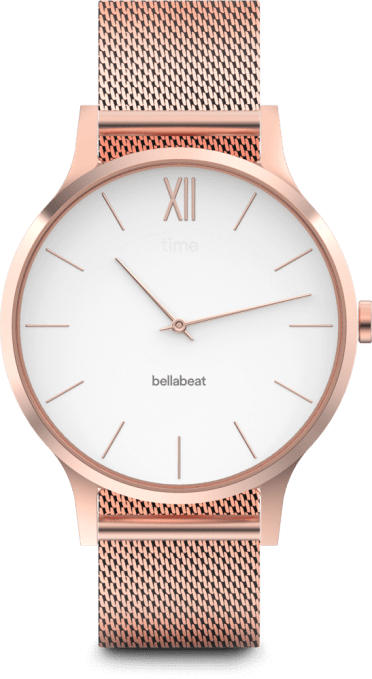 You also don’t have to charge it, which makes it feel more like a “real” watch than a gadget.
You also don’t have to charge it, which makes it feel more like a “real” watch than a gadget.
However, there’s a potential downside here, too – the coin cell battery only lasts “up to” 6 months. You’ll then need to use the tiny tool it ships with to replace the old battery with a new one.
Of course, some will see a user-replaceable battery as a perk. I don’t, but that’s a personal preference on my part.
I much prefer just dropping my Apple Watch onto a charger rather than having to keep up with a small watch tool, which can be easy to lose or misplace in the time between repairs. I’m also not a fan of having to unscrew tiny screws and then finding some sort of small, sharp object to pop out the battery. Perhaps that’s because I have a child with a dozen or so battery-operated toys. I’m constantly unscrewing things to replace batteries, and frankly I don’t need another.
In any event, among the watch’s better aspects is the fact that it packages up fitness and wellness tracking in a device that passes as a regular – and even fairly attractive – piece of fashion jewelry. The Time will go better with some of your outfits where you just don’t think the Apple Watch works – even with one of Apple’s fancier bands.
Of course, it’s not as seamless to use Time as the Apple Watch, which has the Apple platform advantage. (Or an Android smartwatch paired with an Android phone, for that matter.)
Instead, you have to sync your activity between the watch and the third-party Bellabeat app to view things like the steps taken or hours slept. You do so by taping a sync button in the app and double-tapping on the watch face.
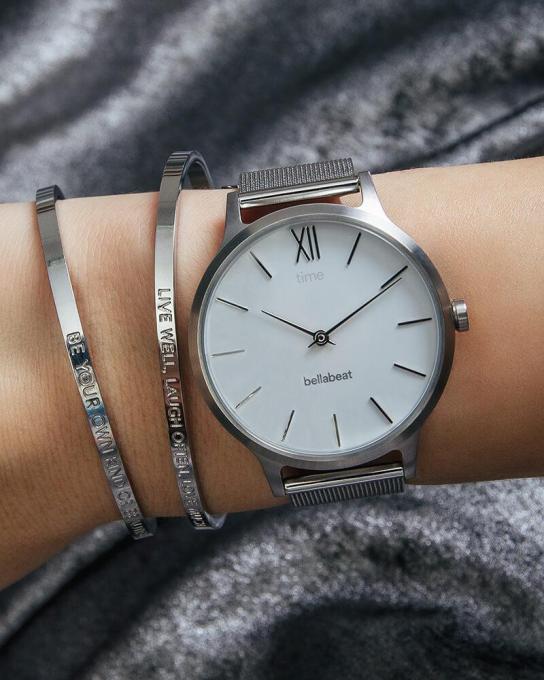
The app can also serve as way to keep up with other aspects of your health and wellness, including your hydration goals, stress, meditation time, and your period.
The stress metrics are calculated for you, based on factors like activity levels, sleep quality, reproductive health, and meditation over the past week. But hydration and menstruation have to be logged manually (*unless you’re using Bellabeat Spring – see below.)
The mediation tracking only calculates your progress through the app’s own selection of over 30 included exercises. While it’s nice to have access to those resources included in the app, many people are already using popular meditation apps like Calm or Headspace. An “import” option for externally-logged “mindful minutes” would have been nice here.
One of Time’s better features are its silent alarms and inactivity alerts. Instead of pings and loud noises, the watch more calmly reminds you of things with vibrations you configure. There are also included alarms for waking up, taking your vitamins, taking your contraception pill, and another general alarm setting, each with their own toggle switches and settings.

There is something to be said for a quieter smartwatch, especially if stress levels are a concern. (There’s also something to be said for a device that’s built by a woman with the needs of women in mind. Remember how long it took for Apple to realize period tracking was a thing?)
That said, it’s unfortunately becoming harder for smaller device makers to compete with the Apple Watch, which has now moved into advanced areas with its Series 4 line, which sports life-saving ECG and fall detection features, along with smarter workout detection (and yes, you can still swim with it), plus its ability to work with the broader iOS app ecosystem in a more native way.
But the Apple Watch is pricier at $399 and up for current models. Bellabeat’s Time, by comparison, is $179.
The Bellabeat mobile app will work with other Bellabeat products, including its wellness tracker Leaf (which can be worn as a bracelet, necklace, clip, etc.), and $59 smart water bottle, Spring.
Combined, the Spring and Time could be a good entry point into the world of fitness and wellness trackers for those who never felt that wearables and trackers were right for them. Bellabeat’s line is more of a lifestyle choice based just as much on looks as on tech, if not more so.
The question now is whether or not Bellabeat can carve out a big enough slice of the smartwatch market, which continues to be dominated by Apple, to sustain itself in the years ahead.
Bellabeat was a Y Combinator 2014 grad founded by female entrepreneur Urska Srsen, and has raised ~$19 million to date, according to Crunchbase. It previously sold products for expectant mothers, as well, but those have been phased out. Bellabeat declined to share any user metrics or revenue figures, when asked.